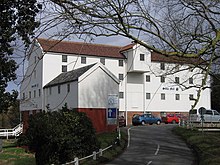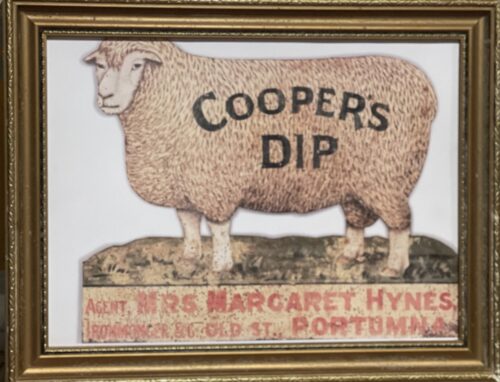-
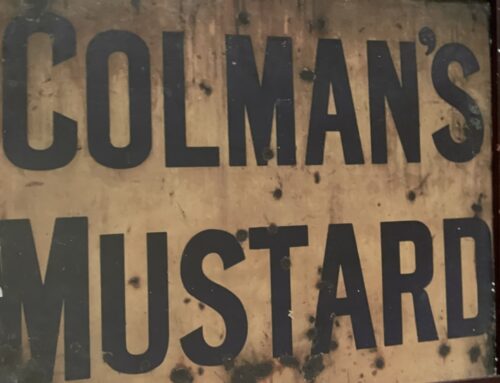
 37cm x 47cm Limerick Colman's (est. in 1814) is an English manufacturer of mustard and other sauces, formerly based and produced for 160 years at Carrow, in Norwich, Norfolk. Owned by Unilever since 1995, Colman's is one of the oldest existing food brands, famous for a limited range of products, almost all varieties of mustard. In 2019 the Colman’s factory in Norwich rolled its last jar of mustard off the production line and its Use By Date was changed for the occasion to: "Norwich's Last. By Its Finest. July 24th 2019". Colman’s continued making other condiments at the Carrow site until closing its doors in early 2020. In the early 1800s, Jeremiah Colman began making mustard at a water mill near Norwich in the village of Bawburgh. To create a tangy flavour, he blended brown mustard (Brassica juncea) with white mustard (Sinapis alba). Jeremiah founded Colman's of Norwich in 1814, at the Stoke Holy Cross mill on the River Tas, four miles south of Norwich. In 1823 he took his adopted nephew, James, into the business which became J. & J. Colman. In 1851 J.J. Colman took over the business. By 1865 production had transferred to a large factory at Carrow Road on land at Thorpe Hamlet, bought from the Norfolk Railway to the south of Norwich,where the firm operated until the Norwich closure. From 1855 the firm introduced its distinctive yellow packaging and bull's head logo, and in 1866 was granted the Royal Warrantas manufacturers of mustard to Queen Victoria. Her Majesty's household still uses Colman's today. The Colman family's pioneering achievements in social welfare are part of Norwich's history. In 1857 a school was opened for the employees' children, while in 1864 the firm employed a nurse to help sick members of staff, a social revolution at the time. From 1896 Jeremiah Colman became chairman.In 1903, the firm took over rival mustard maker Keen Robinson & Company,through which it also acquired the Robinsons barley water and baby food business.The purpose of the acquisition was to reduce competition within the mustard business. By 1909 the company employed 2,300 people. Keen's production was moved from London to Norwich in 1925. Together with Reckitt, the company acquired French's, the American mustard manufacturer, in 1926 for £750,000. In 1938 it merged with Reckitts and Sons of Hull to form the Reckitt & Colman household products conglomerate. From 1997 to 2001, Colman's were the main sponsors of Norwich City Football Club. The Colman's part of the business was demerged in 1995 and Colman's became part of Unilever UK Ltd. As well as mustard, it applies its name to condiments, sauces and other foodstuffs. Reckitt and Colman engaged in cost-cutting as it prepared to sell the brand, getting rid of the agronomy department, which had looked after plant breeding and seed development. Colman's maintains links with Norwich. The founding family are commemorated in street names such as Colman Road (part of the A140 inner ring road), on which is situated Colman's First and Middle Schools. In addition, the Colman House residence at the University of East Anglia is named after the company and Jeremiah Colman.
37cm x 47cm Limerick Colman's (est. in 1814) is an English manufacturer of mustard and other sauces, formerly based and produced for 160 years at Carrow, in Norwich, Norfolk. Owned by Unilever since 1995, Colman's is one of the oldest existing food brands, famous for a limited range of products, almost all varieties of mustard. In 2019 the Colman’s factory in Norwich rolled its last jar of mustard off the production line and its Use By Date was changed for the occasion to: "Norwich's Last. By Its Finest. July 24th 2019". Colman’s continued making other condiments at the Carrow site until closing its doors in early 2020. In the early 1800s, Jeremiah Colman began making mustard at a water mill near Norwich in the village of Bawburgh. To create a tangy flavour, he blended brown mustard (Brassica juncea) with white mustard (Sinapis alba). Jeremiah founded Colman's of Norwich in 1814, at the Stoke Holy Cross mill on the River Tas, four miles south of Norwich. In 1823 he took his adopted nephew, James, into the business which became J. & J. Colman. In 1851 J.J. Colman took over the business. By 1865 production had transferred to a large factory at Carrow Road on land at Thorpe Hamlet, bought from the Norfolk Railway to the south of Norwich,where the firm operated until the Norwich closure. From 1855 the firm introduced its distinctive yellow packaging and bull's head logo, and in 1866 was granted the Royal Warrantas manufacturers of mustard to Queen Victoria. Her Majesty's household still uses Colman's today. The Colman family's pioneering achievements in social welfare are part of Norwich's history. In 1857 a school was opened for the employees' children, while in 1864 the firm employed a nurse to help sick members of staff, a social revolution at the time. From 1896 Jeremiah Colman became chairman.In 1903, the firm took over rival mustard maker Keen Robinson & Company,through which it also acquired the Robinsons barley water and baby food business.The purpose of the acquisition was to reduce competition within the mustard business. By 1909 the company employed 2,300 people. Keen's production was moved from London to Norwich in 1925. Together with Reckitt, the company acquired French's, the American mustard manufacturer, in 1926 for £750,000. In 1938 it merged with Reckitts and Sons of Hull to form the Reckitt & Colman household products conglomerate. From 1997 to 2001, Colman's were the main sponsors of Norwich City Football Club. The Colman's part of the business was demerged in 1995 and Colman's became part of Unilever UK Ltd. As well as mustard, it applies its name to condiments, sauces and other foodstuffs. Reckitt and Colman engaged in cost-cutting as it prepared to sell the brand, getting rid of the agronomy department, which had looked after plant breeding and seed development. Colman's maintains links with Norwich. The founding family are commemorated in street names such as Colman Road (part of the A140 inner ring road), on which is situated Colman's First and Middle Schools. In addition, the Colman House residence at the University of East Anglia is named after the company and Jeremiah Colman. -
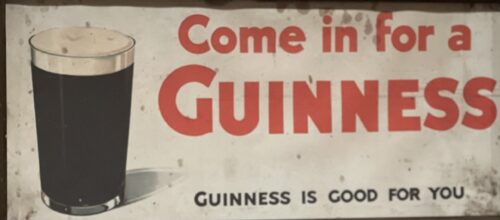
 28cm x 62cm Arthur Guinness started brewing ales in 1759 at the St James Gate Brewery,Dublin.On 31st December 1759 he signed a 9,000 year lease at £45 per annum for the unused brewery.Ten years later, on 19 May 1769, Guinness first exported his ale: he shipped six-and-a-half barrels to Great Britain before he started selling the dark beer porter in 1778. The first Guinness beers to use the term were Single Stout and Double Stout in the 1840s.Throughout the bulk of its history, Guinness produced only three variations of a single beer type: porter or single stout, double or extra and foreign stout for export. “Stout” originally referred to a beer’s strength, but eventually shifted meaning toward body and colour.Porter was also referred to as “plain”, as mentioned in the famous refrain of Flann O’Brien‘s poem “The Workman’s Friend”: “A pint of plain is your only man.” Already one of the top-three British and Irish brewers, Guinness’s sales soared from 350,000 barrels in 1868 to 779,000 barrels in 1876.In October 1886 Guinness became a public company, and was averaging sales of 1,138,000 barrels a year. This was despite the brewery’s refusal to either advertise or offer its beer at a discount. Even though Guinness owned no public houses, the company was valued at £6 million and shares were twenty times oversubscribed, with share prices rising to a 60 per cent premium on the first day of trading. The breweries pioneered several quality control efforts. The brewery hired the statistician William Sealy Gosset in 1899, who achieved lasting fame under the pseudonym “Student” for techniques developed for Guinness, particularly Student’s t-distribution and the even more commonly known Student’s t-test. By 1900 the brewery was operating unparalleled welfare schemes for its 5,000 employees. By 1907 the welfare schemes were costing the brewery £40,000 a year, which was one-fifth of the total wages bill. The improvements were suggested and supervised by Sir John Lumsden. By 1914, Guinness was producing 2,652,000 barrels of beer a year, which was more than double that of its nearest competitor Bass, and was supplying more than 10 per cent of the total UK beer market. In the 1930s, Guinness became the seventh largest company in the world. Before 1939, if a Guinness brewer wished to marry a Catholic, his resignation was requested. According to Thomas Molloy, writing in the Irish Independent, “It had no qualms about selling drink to Catholics but it did everything it could to avoid employing them until the 1960s.” Guinness thought they brewed their last porter in 1973. In the 1970s, following declining sales, the decision was taken to make Guinness Extra Stout more “drinkable”. The gravity was subsequently reduced, and the brand was relaunched in 1981. Pale malt was used for the first time, and isomerized hop extract began to be used. In 2014, two new porters were introduced: West Indies Porter and Dublin Porter. Guinness acquired the Distillers Company in 1986.This led to a scandal and criminal trialconcerning the artificial inflation of the Guinness share price during the takeover bid engineered by the chairman, Ernest Saunders. A subsequent £5.2 million success fee paid to an American lawyer and Guinness director, Tom Ward, was the subject of the case Guinness plc v Saunders, in which the House of Lords declared that the payment had been invalid. In the 1980s, as the IRA’s bombing campaign spread to London and the rest of Britain, Guinness considered scrapping the Harp as its logo. The company merged with Grand Metropolitan in 1997 to form Diageo. Due to controversy over the merger, the company was maintained as a separate entity within Diageo and has retained the rights to the product and all associated trademarks of Guinness.The Guinness brewery in Park Royal, London closed in 2005. The production of all Guinness sold in the UK and Ireland was moved to St. James’s Gate Brewery, Dublin. Guinness has also been referred to as “that black stuff”. Guinness had a fleet of ships, barges and yachts. The Irish Sunday Independent newspaper reported on 17 June 2007 that Diageo intended to close the historic St James’s Gate plant in Dublin and move to a greenfield site on the outskirts of the city.This news caused some controversy when it was announced.The following day, the Irish Daily Mail ran a follow-up story with a double page spread complete with images and a history of the plant since 1759. Initially, Diageo said that talk of a move was pure speculation but in the face of mounting speculation in the wake of the Sunday Independent article, the company confirmed that it is undertaking a “significant review of its operations”. This review was largely due to the efforts of the company’s ongoing drive to reduce the environmental impact of brewing at the St James’s Gate plant. On 23 November 2007, an article appeared in the Evening Herald, a Dublin newspaper, stating that the Dublin City Council, in the best interests of the city of Dublin, had put forward a motion to prevent planning permission ever being granted for development of the site, thus making it very difficult for Diageo to sell off the site for residential development. On 9 May 2008, Diageo announced that the St James’s Gate brewery will remain open and undergo renovations, but that breweries in Kilkenny and Dundalk will be closed by 2013 when a new larger brewery is opened near Dublin. The result will be a loss of roughly 250 jobs across the entire Diageo/Guinness workforce in Ireland.Two days later, the Sunday Independent again reported that Diageo chiefs had met with Tánaiste Mary Coughlan, the deputy leader of the Government of Ireland, about moving operations to Ireland from the UK to benefit from its lower corporation tax rates. Several UK firms have made the move in order to pay Ireland’s 12.5 per cent rate rather than the UK’s 28 per cent rate. Diageo released a statement to the London stock exchange denying the report.Despite the merger that created Diageo plc in 1997, Guinness has retained its right to the Guinness brand and associated trademarks and thus continues to trade under the traditional Guinness name despite trading under the corporation name Diageo for a brief period in 1997. In November 2015 it was announced that Guinness are planning to make their beer suitable for consumption by vegetarians and vegans by the end of 2016 through the introduction of a new filtration process at their existing Guinness Brewery that avoids the need to use isinglass from fish bladders to filter out yeast particles.This went into effect in 2017, per the company’s FAQ webpage where they state: “Our new filtration process has removed the use of isinglass as a means of filtration and vegans can now enjoy a pint of Guinness. All Guinness Draught in keg format is brewed without using isinglass. Full distribution of bottle and can formats will be in place by the end of 2017, so until then, our advice to vegans is to consume the product from the keg format only for now. Guinness stout is made from water, barley, roast malt extract, hops, and brewer’s yeast. A portion of the barley is roasted to give Guinness its dark colour and characteristic taste. It is pasteurisedand filtered. Until the late 1950s Guinness was still racked into wooden casks. In the late 1950s and early 1960s, Guinness ceased brewing cask-conditioned beers and developed a keg brewing system with aluminium kegs replacing the wooden casks; these were nicknamed “iron lungs”.Until 2016 the production of Guinness, as with many beers, involved the use of isinglass made from fish. Isinglass was used as a fining agent for settling out suspended matter in the vat. The isinglass was retained in the floor of the vat but it was possible that minute quantities might be carried over into the beer. Diageo announced in February 2018 that the use of isinglass in draught Guinness was to be discontinued and an alternative clarification agent would be used instead. This has made draught Guinness acceptable to vegans and vegetarians. Arguably its biggest change to date, in 1959 Guinness began using nitrogen, which changed the fundamental texture and flavour of the Guinness of the past as nitrogen bubbles are much smaller than CO2, giving a “creamier” and “smoother” consistency over a sharper and traditional CO2 taste. This step was taken after Michael Ash – a mathematician turned brewer – discovered the mechanism to make this possible. Nitrogen is less soluble than carbon dioxide, which allows the beer to be put under high pressure without making it fizzy. High pressure of the dissolved gas is required to enable very small bubbles to be formed by forcing the draught beer through fine holes in a plate in the tap, which causes the characteristic “surge” (the widget in cans and bottles achieves the same effect). This “widget” is a small plastic ball containing the nitrogen. The perceived smoothness of draught Guinness is due to its low level of carbon dioxide and the creaminess of the head caused by the very fine bubbles that arise from the use of nitrogen and the dispensing method described above. “Foreign Extra Stout” contains more carbon dioxide, causing a more acidic taste. Contemporary Guinness Draught and Extra Stout are weaker than they were in the 19th century, when they had an original gravity of over 1.070. Foreign Extra Stout and Special Export Stout, with abv of 7.5% and 9% respectively, are perhaps closest to the original in character.Although Guinness may appear to be black, it is officially a very dark shade of ruby. The most recent change in alcohol content from the Import Stout to the Extra Stout was due to a change in distribution through North American market. Consumer complaints have influenced recent distribution and bottle changes. Studies claim that Guinness can be beneficial to the heart. Researchers found that “‘antioxidantcompounds’ in the Guinness, similar to those found in certain fruits and vegetables, are responsible for the health benefits because they slow down the deposit of harmful cholesterol on the artery walls.”Guinness ran an advertising campaign in the 1920s which stemmed from market research – when people told the company that they felt good after their pint, the slogan, created by Dorothy L. Sayers–”Guinness is Good for You”. Advertising for alcoholic drinks that implies improved physical performance or enhanced personal qualities is now prohibited in Ireland.Diageo, the company that now manufactures Guinness, says: “We never make any medical claims for our drinks.”
28cm x 62cm Arthur Guinness started brewing ales in 1759 at the St James Gate Brewery,Dublin.On 31st December 1759 he signed a 9,000 year lease at £45 per annum for the unused brewery.Ten years later, on 19 May 1769, Guinness first exported his ale: he shipped six-and-a-half barrels to Great Britain before he started selling the dark beer porter in 1778. The first Guinness beers to use the term were Single Stout and Double Stout in the 1840s.Throughout the bulk of its history, Guinness produced only three variations of a single beer type: porter or single stout, double or extra and foreign stout for export. “Stout” originally referred to a beer’s strength, but eventually shifted meaning toward body and colour.Porter was also referred to as “plain”, as mentioned in the famous refrain of Flann O’Brien‘s poem “The Workman’s Friend”: “A pint of plain is your only man.” Already one of the top-three British and Irish brewers, Guinness’s sales soared from 350,000 barrels in 1868 to 779,000 barrels in 1876.In October 1886 Guinness became a public company, and was averaging sales of 1,138,000 barrels a year. This was despite the brewery’s refusal to either advertise or offer its beer at a discount. Even though Guinness owned no public houses, the company was valued at £6 million and shares were twenty times oversubscribed, with share prices rising to a 60 per cent premium on the first day of trading. The breweries pioneered several quality control efforts. The brewery hired the statistician William Sealy Gosset in 1899, who achieved lasting fame under the pseudonym “Student” for techniques developed for Guinness, particularly Student’s t-distribution and the even more commonly known Student’s t-test. By 1900 the brewery was operating unparalleled welfare schemes for its 5,000 employees. By 1907 the welfare schemes were costing the brewery £40,000 a year, which was one-fifth of the total wages bill. The improvements were suggested and supervised by Sir John Lumsden. By 1914, Guinness was producing 2,652,000 barrels of beer a year, which was more than double that of its nearest competitor Bass, and was supplying more than 10 per cent of the total UK beer market. In the 1930s, Guinness became the seventh largest company in the world. Before 1939, if a Guinness brewer wished to marry a Catholic, his resignation was requested. According to Thomas Molloy, writing in the Irish Independent, “It had no qualms about selling drink to Catholics but it did everything it could to avoid employing them until the 1960s.” Guinness thought they brewed their last porter in 1973. In the 1970s, following declining sales, the decision was taken to make Guinness Extra Stout more “drinkable”. The gravity was subsequently reduced, and the brand was relaunched in 1981. Pale malt was used for the first time, and isomerized hop extract began to be used. In 2014, two new porters were introduced: West Indies Porter and Dublin Porter. Guinness acquired the Distillers Company in 1986.This led to a scandal and criminal trialconcerning the artificial inflation of the Guinness share price during the takeover bid engineered by the chairman, Ernest Saunders. A subsequent £5.2 million success fee paid to an American lawyer and Guinness director, Tom Ward, was the subject of the case Guinness plc v Saunders, in which the House of Lords declared that the payment had been invalid. In the 1980s, as the IRA’s bombing campaign spread to London and the rest of Britain, Guinness considered scrapping the Harp as its logo. The company merged with Grand Metropolitan in 1997 to form Diageo. Due to controversy over the merger, the company was maintained as a separate entity within Diageo and has retained the rights to the product and all associated trademarks of Guinness.The Guinness brewery in Park Royal, London closed in 2005. The production of all Guinness sold in the UK and Ireland was moved to St. James’s Gate Brewery, Dublin. Guinness has also been referred to as “that black stuff”. Guinness had a fleet of ships, barges and yachts. The Irish Sunday Independent newspaper reported on 17 June 2007 that Diageo intended to close the historic St James’s Gate plant in Dublin and move to a greenfield site on the outskirts of the city.This news caused some controversy when it was announced.The following day, the Irish Daily Mail ran a follow-up story with a double page spread complete with images and a history of the plant since 1759. Initially, Diageo said that talk of a move was pure speculation but in the face of mounting speculation in the wake of the Sunday Independent article, the company confirmed that it is undertaking a “significant review of its operations”. This review was largely due to the efforts of the company’s ongoing drive to reduce the environmental impact of brewing at the St James’s Gate plant. On 23 November 2007, an article appeared in the Evening Herald, a Dublin newspaper, stating that the Dublin City Council, in the best interests of the city of Dublin, had put forward a motion to prevent planning permission ever being granted for development of the site, thus making it very difficult for Diageo to sell off the site for residential development. On 9 May 2008, Diageo announced that the St James’s Gate brewery will remain open and undergo renovations, but that breweries in Kilkenny and Dundalk will be closed by 2013 when a new larger brewery is opened near Dublin. The result will be a loss of roughly 250 jobs across the entire Diageo/Guinness workforce in Ireland.Two days later, the Sunday Independent again reported that Diageo chiefs had met with Tánaiste Mary Coughlan, the deputy leader of the Government of Ireland, about moving operations to Ireland from the UK to benefit from its lower corporation tax rates. Several UK firms have made the move in order to pay Ireland’s 12.5 per cent rate rather than the UK’s 28 per cent rate. Diageo released a statement to the London stock exchange denying the report.Despite the merger that created Diageo plc in 1997, Guinness has retained its right to the Guinness brand and associated trademarks and thus continues to trade under the traditional Guinness name despite trading under the corporation name Diageo for a brief period in 1997. In November 2015 it was announced that Guinness are planning to make their beer suitable for consumption by vegetarians and vegans by the end of 2016 through the introduction of a new filtration process at their existing Guinness Brewery that avoids the need to use isinglass from fish bladders to filter out yeast particles.This went into effect in 2017, per the company’s FAQ webpage where they state: “Our new filtration process has removed the use of isinglass as a means of filtration and vegans can now enjoy a pint of Guinness. All Guinness Draught in keg format is brewed without using isinglass. Full distribution of bottle and can formats will be in place by the end of 2017, so until then, our advice to vegans is to consume the product from the keg format only for now. Guinness stout is made from water, barley, roast malt extract, hops, and brewer’s yeast. A portion of the barley is roasted to give Guinness its dark colour and characteristic taste. It is pasteurisedand filtered. Until the late 1950s Guinness was still racked into wooden casks. In the late 1950s and early 1960s, Guinness ceased brewing cask-conditioned beers and developed a keg brewing system with aluminium kegs replacing the wooden casks; these were nicknamed “iron lungs”.Until 2016 the production of Guinness, as with many beers, involved the use of isinglass made from fish. Isinglass was used as a fining agent for settling out suspended matter in the vat. The isinglass was retained in the floor of the vat but it was possible that minute quantities might be carried over into the beer. Diageo announced in February 2018 that the use of isinglass in draught Guinness was to be discontinued and an alternative clarification agent would be used instead. This has made draught Guinness acceptable to vegans and vegetarians. Arguably its biggest change to date, in 1959 Guinness began using nitrogen, which changed the fundamental texture and flavour of the Guinness of the past as nitrogen bubbles are much smaller than CO2, giving a “creamier” and “smoother” consistency over a sharper and traditional CO2 taste. This step was taken after Michael Ash – a mathematician turned brewer – discovered the mechanism to make this possible. Nitrogen is less soluble than carbon dioxide, which allows the beer to be put under high pressure without making it fizzy. High pressure of the dissolved gas is required to enable very small bubbles to be formed by forcing the draught beer through fine holes in a plate in the tap, which causes the characteristic “surge” (the widget in cans and bottles achieves the same effect). This “widget” is a small plastic ball containing the nitrogen. The perceived smoothness of draught Guinness is due to its low level of carbon dioxide and the creaminess of the head caused by the very fine bubbles that arise from the use of nitrogen and the dispensing method described above. “Foreign Extra Stout” contains more carbon dioxide, causing a more acidic taste. Contemporary Guinness Draught and Extra Stout are weaker than they were in the 19th century, when they had an original gravity of over 1.070. Foreign Extra Stout and Special Export Stout, with abv of 7.5% and 9% respectively, are perhaps closest to the original in character.Although Guinness may appear to be black, it is officially a very dark shade of ruby. The most recent change in alcohol content from the Import Stout to the Extra Stout was due to a change in distribution through North American market. Consumer complaints have influenced recent distribution and bottle changes. Studies claim that Guinness can be beneficial to the heart. Researchers found that “‘antioxidantcompounds’ in the Guinness, similar to those found in certain fruits and vegetables, are responsible for the health benefits because they slow down the deposit of harmful cholesterol on the artery walls.”Guinness ran an advertising campaign in the 1920s which stemmed from market research – when people told the company that they felt good after their pint, the slogan, created by Dorothy L. Sayers–”Guinness is Good for You”. Advertising for alcoholic drinks that implies improved physical performance or enhanced personal qualities is now prohibited in Ireland.Diageo, the company that now manufactures Guinness, says: “We never make any medical claims for our drinks.” -

 Fantastic Cowan's Old Irish Whisky Advertising print. 66cm x 75cm Ballymena Co AntrimFeaturing what appears to be smugglers offloading some of William Cowan's finest Irish Whisky ashore.Cowan's was a major distilling firm with operations on both sides of the North Channel,operating out of both Loch Lomond and Belfast.
Fantastic Cowan's Old Irish Whisky Advertising print. 66cm x 75cm Ballymena Co AntrimFeaturing what appears to be smugglers offloading some of William Cowan's finest Irish Whisky ashore.Cowan's was a major distilling firm with operations on both sides of the North Channel,operating out of both Loch Lomond and Belfast.




 antr
antr Origins : Co AntrimDimensions : 56cm x 66cm 5kg
Origins : Co AntrimDimensions : 56cm x 66cm 5kg -
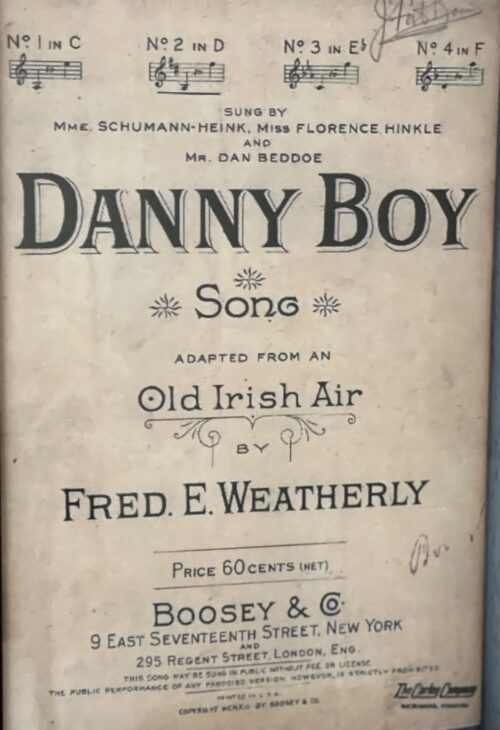
 35cm x 25cm Limerick"Danny Boy" is a ballad, written by English songwriter Frederic Weatherly in 1913, and set to the traditional Irish melody of "Londonderry Air".
35cm x 25cm Limerick"Danny Boy" is a ballad, written by English songwriter Frederic Weatherly in 1913, and set to the traditional Irish melody of "Londonderry Air".
In 1910, in Bath, Somerset, the English lawyer and lyricist Frederic Weatherly initially wrote the words to "Danny Boy" to a tune other than "Londonderry Air". After his Irish-born sister-in-law Margaret Enright Weatherly (known as Jess) in the United States sent him a copy of "Londonderry Air" in 1913 (an alternative version of the story has her singing the air to him in 1912 with different lyrics), Weatherly modified the lyrics of "Danny Boy" to fit the rhyme and meter of "Londonderry Air". Weatherly gave the song to the vocalist Elsie Griffin, who made it one of the most popular songs of the new century. In 1915, Ernestine Schumann-Heink produced the first recording of "Danny Boy". Jane Ross of Limavady is credited with collecting the melody of "Londonderry Air" in the mid-19th century from a musician she encountered."Danny Boy"  Danny Boy
Danny BoySong Published 1913 Genre Folk Songwriter(s) Frederic Weatherly (lyrics) in 1910 Recording Performed by Celtic Aire of the United States Air Force BandLyrics
The 1913 lyrics by Frederick E. Weatherly:Oh, Danny boy, the pipes, the pipes are calling From glen to glen, and down the mountain side. The summer's gone, and all the roses falling, It's you, It's you must go and I must bide. But come ye back when summer's in the meadow, Or when the valley's hushed and white with snow, It's I'll be there in sunshine or in shadow,— Oh, Danny boy, Oh Danny boy, I love you so! But when ye come, and all the flowers are dying, If I am dead, as dead I well may be, Ye'll come and find the place where I am lying, And kneel and say an Avé there for me. And I shall hear, though soft you tread above me, And all my grave will warmer, sweeter be, For you will bend and tell me that you love me, And I shall sleep in peace until you come to me!Meaning
There are various conjectures about the meaning of "Danny Boy".Some interpret the song to be a message from a parent to a son going off to war or participating in the Irish uprising (as suggested by the reference to "pipes calling glen to glen") or emigrating as part of the Irish diaspora. The 1918 version of the sheet music with Weatherly's printed signature included alternative lyrics ("Eily Dear"), with the instructions that "when sung by a man, the words in italic should be used; the song then becomes "Eily Dear", so that "Danny Boy" is only to be sung by a lady". Nonetheless, it is unclear whether this was Weatherly's intent.Usage
- Percy Grainger's Irish Tune from County Derry adapts the Danny Boy/Londonderry Air melody for wind ensemble in 1918.
- The song is popular for funerals; but the National Catholic Reporter wrote in 2001 that it "cannot be played during Mass."
Select recordings
"Danny Boy" has been recorded multiple times by a variety of performers. Several versions are listed below in chronological order.- 1940 Judy Garland Little Nellie Kelly soundtrack. Garland also sang it live at her concerts in Ireland and Scotland and most famously at her New York Palace Theatre debut in 1951.
- 1940 Glenn Miller and His Orchestra released a single that climbed to #17 in "Pop Memories 1890-1954" (not Billboard's charts);Arranged by Glenn Miller and pianist Chummy MacGregor.
- 1941 Bing Crosby Merry Christmas. "Danny Boy" was paired with "I'll Be Home for Christmas" on its original single. Recorded July 5, 1941.
- 1941 Deanna Durbin in the film It Started with Eve
- 1950 Al Hibbler released a single that rose to #9 on the R&B chart[12]
- 1959 Conway Twitty's version charted at #10 on the Billboard Hot 100, #18 on Top R&B.(banned by the BBC)
- 1961 Andy Williams used the song's title for his album Danny Boy and Other Songs I Love to Sing. The single hit #15 on the U.S. adult contemporary and #64 on the Hot 100 charts.
- 1964 Patti LaBelle and the Bluebelles released a single that peaked at #76 on the Hot 100.
- 1965 Jackie Wilson's version rose to #94 on the Hot 100 and #25 on the R&B charts.
- 1967 Ray Price's single hit #60 on the Hot 100 and #9 on the Country charts.
- 1992 Eric Clapton recorded an instrumental version released as a bonus track for Change the World [6]
- 1992 John McDermott released the song as an independent single.
- 1998 Sinéad O'Connor sang the song over Davy Spillane's uilleann pipes on Spillane's album The Sea of Dreams. Actor-filmmaker Gabriel Byrne said this version is his favourite.
- 2002 Johnny Cash recorded the song on his album American IV: The Man Comes Around, working with producer Rick Rubin in what would come to be the last album released during his lifetime. Cash had previously recorded the
-
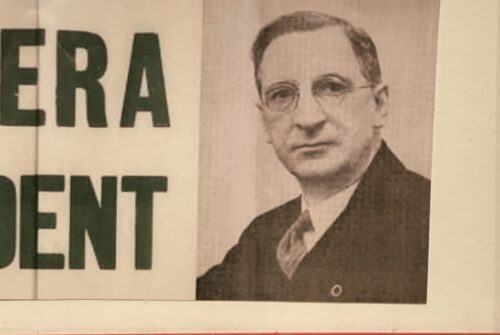
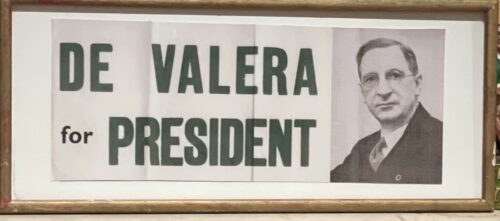 30cm x 65cmBEFORE THE ADVENT of opinion polls, by-elections were the most reliable means of gauging the mood of the electorate.For decades before the 1916 Rising, Irish nationalists represented by the Irish Parliamentary Party (IPP) sought Irish home rule – a subordinate parliament and government in Dublin.But the emergence of Sinn Féin, which championed an independent Irish republic, transformed the political landscape. In 1917 Sinn Féin won four by-elections on the bounce in North Roscommon, South Longford, East Clare and South Kilkenny.No victory was more emphatic than East Clare and no winning candidate more central to the future history of Ireland.A political noviceThe victor was a political novice with little experience of public speaking outside the classroom. The senior surviving Volunteer from 1916, he was largely unknown before the East Clare by-election.But after it he was catapulted to national prominence, became president of Sinn Féin and represented East Clare for the next four decades. That soldier turned politician was De Valera .The East Clare by-election on July 10 was precipitated by the death on the Western Front of the sitting MP: Major Willie Redmond, brother of the leader of the IPP.Patrick Lynch KC, a barrister, contested the seat for the IPP under the banner: “Clare for a Clareman – Lynch is the Man”. His supporters, who were strongest in Ennis, contended that an Irish republic was a political fantasy. For several reasons, few expected anything other than a Sinn Féin victory.One of the most rebellious counties in IrelandFirst, Clare was one of the most rebellious counties in Ireland and during the by-election the county inspector of the Royal Irish Constabulary had to obtain a draft of 150 soldiers. Eight months after the by-election Clare became the first county to be placed under military rule since the 1916 Rising.Second, no election had been contested in East Clare since 1895 and the IPP’s constituency machine was decrepit and almost bankrupt. By contrast, the Sinn Féin campaign was highly organised and backboned by the revamped Irish Volunteers who were unafraid to defy the authorities and acted as a private police force.De Valera, who had only been released from prison on 16 June, campaigned in his Volunteer uniform and told the electors that, “every vote you give now is as good as the crack of a rifle in proclaiming your desire for freedom”.Third, buoyed up by its earlier electoral successes Sinn Féin attracted not just the support of the young but that of the Clare Champion (the county newspaper) and, more significantly, the endorsement of Bishop Michael Fogarty of Killaloe and the majority of younger clergy. The Catholic card was played astutely and reassuringly by de Valera.Although everyone expected a victory for de Valera, no one expected so stunning a winning margin. When the result of the election was announced on July 11 de Valera had secured 5,010 votes to Lynch’s 2,035.A game changerThe rural vote had turned against the IPP. The Freeman’s Journal, the newspaper of the IPP, lamented that, “East Clare has declared for revolution by an overwhelming majority”. Lynch was not the man after all.The East Clare by-election was a milestone for Sinn Féin because it secured a striking popular mandate which helped the organisation to continue its rapid growth ahead of the 1918 general election.For de Valera his victory was a pivotal episode in his progression from militant to political republican. More than any other factor, the scale of his success propelled him to the presidency of Sinn Féin in October 1917 and launched his long political career. For a man who in the early months of 1917 wished to have no truck with politics this was quite a turn of events.
30cm x 65cmBEFORE THE ADVENT of opinion polls, by-elections were the most reliable means of gauging the mood of the electorate.For decades before the 1916 Rising, Irish nationalists represented by the Irish Parliamentary Party (IPP) sought Irish home rule – a subordinate parliament and government in Dublin.But the emergence of Sinn Féin, which championed an independent Irish republic, transformed the political landscape. In 1917 Sinn Féin won four by-elections on the bounce in North Roscommon, South Longford, East Clare and South Kilkenny.No victory was more emphatic than East Clare and no winning candidate more central to the future history of Ireland.A political noviceThe victor was a political novice with little experience of public speaking outside the classroom. The senior surviving Volunteer from 1916, he was largely unknown before the East Clare by-election.But after it he was catapulted to national prominence, became president of Sinn Féin and represented East Clare for the next four decades. That soldier turned politician was De Valera .The East Clare by-election on July 10 was precipitated by the death on the Western Front of the sitting MP: Major Willie Redmond, brother of the leader of the IPP.Patrick Lynch KC, a barrister, contested the seat for the IPP under the banner: “Clare for a Clareman – Lynch is the Man”. His supporters, who were strongest in Ennis, contended that an Irish republic was a political fantasy. For several reasons, few expected anything other than a Sinn Féin victory.One of the most rebellious counties in IrelandFirst, Clare was one of the most rebellious counties in Ireland and during the by-election the county inspector of the Royal Irish Constabulary had to obtain a draft of 150 soldiers. Eight months after the by-election Clare became the first county to be placed under military rule since the 1916 Rising.Second, no election had been contested in East Clare since 1895 and the IPP’s constituency machine was decrepit and almost bankrupt. By contrast, the Sinn Féin campaign was highly organised and backboned by the revamped Irish Volunteers who were unafraid to defy the authorities and acted as a private police force.De Valera, who had only been released from prison on 16 June, campaigned in his Volunteer uniform and told the electors that, “every vote you give now is as good as the crack of a rifle in proclaiming your desire for freedom”.Third, buoyed up by its earlier electoral successes Sinn Féin attracted not just the support of the young but that of the Clare Champion (the county newspaper) and, more significantly, the endorsement of Bishop Michael Fogarty of Killaloe and the majority of younger clergy. The Catholic card was played astutely and reassuringly by de Valera.Although everyone expected a victory for de Valera, no one expected so stunning a winning margin. When the result of the election was announced on July 11 de Valera had secured 5,010 votes to Lynch’s 2,035.A game changerThe rural vote had turned against the IPP. The Freeman’s Journal, the newspaper of the IPP, lamented that, “East Clare has declared for revolution by an overwhelming majority”. Lynch was not the man after all.The East Clare by-election was a milestone for Sinn Féin because it secured a striking popular mandate which helped the organisation to continue its rapid growth ahead of the 1918 general election.For de Valera his victory was a pivotal episode in his progression from militant to political republican. More than any other factor, the scale of his success propelled him to the presidency of Sinn Féin in October 1917 and launched his long political career. For a man who in the early months of 1917 wished to have no truck with politics this was quite a turn of events. -
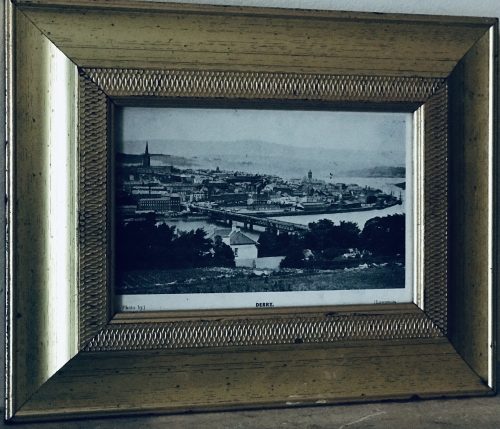 Original vintage postcard depicting Derry,photograph taken by William Lawrence the famous photographer. 18cm x 23cmThe Lawrence Collection is the single most significant collection in the early development of postcards in Ireland. Named after William Lawrence who opened a photographic studio and fancy goods shop in Sackville Street (now O'Connell Street) in 1865, the venture was well-timed to capitalise on the popularity of the postcard. The Collection eventually comprised 40,000 negatives. Robert French (1841-1917) was employed as chief photographer and he along with others travelled the length of the country over a period of more than 20 years. Killarney was the principal attraction in Kerry and all the beauty spots are well represented. However, the photographs of towns and villages are of most historical interest. In many cases they are the only visual records for the turn of the 19th century. Local people were often included in street scenes and it is clear from their fascination with the process that photography was still very much a novelty.While Lawrence's business flourished for nearly fifty years, it declined in the second decade of the 20th century due to the more widespread availability of photographs and the advent of the "Brownie" camera Gallery
Original vintage postcard depicting Derry,photograph taken by William Lawrence the famous photographer. 18cm x 23cmThe Lawrence Collection is the single most significant collection in the early development of postcards in Ireland. Named after William Lawrence who opened a photographic studio and fancy goods shop in Sackville Street (now O'Connell Street) in 1865, the venture was well-timed to capitalise on the popularity of the postcard. The Collection eventually comprised 40,000 negatives. Robert French (1841-1917) was employed as chief photographer and he along with others travelled the length of the country over a period of more than 20 years. Killarney was the principal attraction in Kerry and all the beauty spots are well represented. However, the photographs of towns and villages are of most historical interest. In many cases they are the only visual records for the turn of the 19th century. Local people were often included in street scenes and it is clear from their fascination with the process that photography was still very much a novelty.While Lawrence's business flourished for nearly fifty years, it declined in the second decade of the 20th century due to the more widespread availability of photographs and the advent of the "Brownie" camera Gallery -
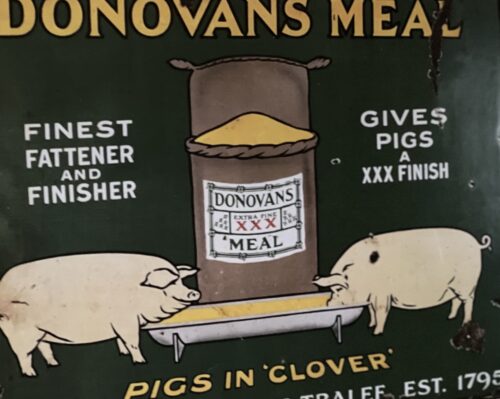
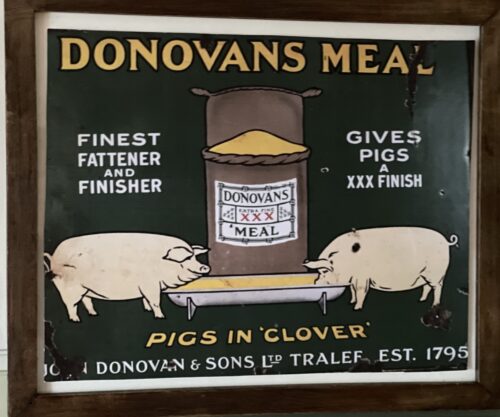 45cm x 35cm I got this piece of interesting information from ‘The Unquiet Grave‘, The Development of Kerry’s Burial Grounds through the Ages – that very interesting book edited by Michael Connolly for Kerry County Council. The chapter on A Tale of Two Tombs tells the fascinating story of the rise and fall of the Donovan family of Tralee, who were wealthy merchants in the town through three generations in 1800’s. Some of you will remember that the Donovans also owned the Jeanie Johnston, which was the Donovan’s most important ship carrying emigrants on the outward journey to Quebec and bringing cargoes of timber back on the return voyage. John Donovan was the founding father and set up a hardware business initially in the Square, Tralee and then branched out leasing and owning shipping bringing iron, coal and slate to Tralee. His sons Nicholas and Henry followed him, they also became the leading political as well as the leading merchants in the town. There is a brilliant description of John’s funeral . He died in 1864 when he was 82 and we are told ‘All the stops were pulled out for the full pageantry of Victorian obsequies’. The Kerry Evening Post reported ‘an unusual grief had fallen upon the town’. According to the same newspaper there were 174 carriages, and there was an important extra little detail -‘the majority were drawn by two horses’ – a two-horse carriage indicated greater social standing than a one-horse carriage’ Try and get hold of this very interesting book from the County Council or log on here for the digital version. And were there any women there at all? Yes, but they were there with a purpose – to provide the all important keening that was then the expected norm at all funerals of all classes. At this funeral we are told ‘The poor of the town, beneficiaries of John Donovan’s generosity, congregated outside the house in The Square, and when the coffin was removed to the hearse, they set up an immense keening, which they continued as they followed the funeral all the way to Ballyseedy’. Another interesting fact relating to women and their own funerals at this time was that ‘while men were buried in the middle of the day, the women, on the other hand were buried early in the morning, regardless of the time of year’. John Donovan’s own wife Catherine was buried in the dark at 6am on a February morning and Nicholas’ wife was buried at the same time in December 1878. ‘Only Henry’s wife was buried in daylight and that was because the burial was at 8am on an August morning in 1885. The higher status of men was constantly affirmed. We have come a long way!
45cm x 35cm I got this piece of interesting information from ‘The Unquiet Grave‘, The Development of Kerry’s Burial Grounds through the Ages – that very interesting book edited by Michael Connolly for Kerry County Council. The chapter on A Tale of Two Tombs tells the fascinating story of the rise and fall of the Donovan family of Tralee, who were wealthy merchants in the town through three generations in 1800’s. Some of you will remember that the Donovans also owned the Jeanie Johnston, which was the Donovan’s most important ship carrying emigrants on the outward journey to Quebec and bringing cargoes of timber back on the return voyage. John Donovan was the founding father and set up a hardware business initially in the Square, Tralee and then branched out leasing and owning shipping bringing iron, coal and slate to Tralee. His sons Nicholas and Henry followed him, they also became the leading political as well as the leading merchants in the town. There is a brilliant description of John’s funeral . He died in 1864 when he was 82 and we are told ‘All the stops were pulled out for the full pageantry of Victorian obsequies’. The Kerry Evening Post reported ‘an unusual grief had fallen upon the town’. According to the same newspaper there were 174 carriages, and there was an important extra little detail -‘the majority were drawn by two horses’ – a two-horse carriage indicated greater social standing than a one-horse carriage’ Try and get hold of this very interesting book from the County Council or log on here for the digital version. And were there any women there at all? Yes, but they were there with a purpose – to provide the all important keening that was then the expected norm at all funerals of all classes. At this funeral we are told ‘The poor of the town, beneficiaries of John Donovan’s generosity, congregated outside the house in The Square, and when the coffin was removed to the hearse, they set up an immense keening, which they continued as they followed the funeral all the way to Ballyseedy’. Another interesting fact relating to women and their own funerals at this time was that ‘while men were buried in the middle of the day, the women, on the other hand were buried early in the morning, regardless of the time of year’. John Donovan’s own wife Catherine was buried in the dark at 6am on a February morning and Nicholas’ wife was buried at the same time in December 1878. ‘Only Henry’s wife was buried in daylight and that was because the burial was at 8am on an August morning in 1885. The higher status of men was constantly affirmed. We have come a long way! -
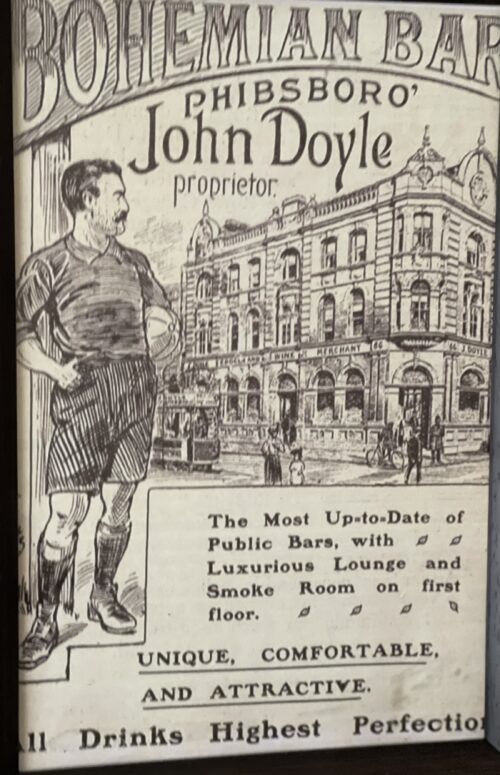
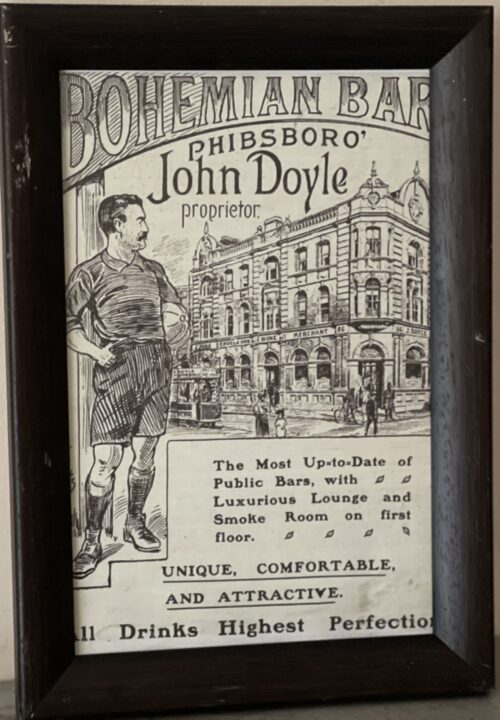 25cm x 35cm LimerickAnd given that The Bohemian is situated on Doyle’s Corner it seems an apt subject. Doyle’s Corner has an interesting history of which this particular pub is a part of. Back around the turn of the century, the intersection of The North Circular and The Phibsborough Road was known as Dunphy’s Corner. Now, this is where it starts to get a bit confusing because the word Doyle is about to be bandied about as much as it might do in a series or two of Father Ted. The name Dunphy’s Corner was derived from another public house which sits directly across the road from The Bohemian – now named Doyle’s Corner, formerly named Doyle’s. The pub that provided this named was owned by a man named Thomas Dunphy who presided over it from the mid-1800s up to around the 1890s. The name Dunphy’s Corner must have been widely used by Dubliners because it’s well represented in song, literature and lore. It gets a mention in Peadar Kearney’s anti-enlistment Ballad about the recruiting sergeant William Bailey (Lankum do a great version), who is said to have stood on the corner in the process of his enlisting. And Peadar might have been working on a subliminal as well as a perceptible level here because ‘going round Dunphy’s Corner‘, as it would have been put, was seemingly an idiom used to describe those who had gone to the great beyond, given its nodal point on the route taken by hearses on their way to Glasnevin. Those familiar with the first half of Ulysses, might remember that Poor Dignam went the very same way along that route in the earlier stages of the book. So in the mid-1890s or so along came John Doyle. And John Doyle fancied he might usurp Dunphy and in setting about doing this, he acquired both number 160 and number 66 Phibsborough Road and placed within each of them a public house which bore his name. It was a trick the evidently worked because, as I’m sure you will know, the corner is still referred to as Doyle’s. Seemingly someone by the name of Murphy – proprietor of the nearby Botanic House – took ownership of The Bohemian in the 1970s and figured he could usurp Doyle by erecting signs which read ‘Murphy’s Corner’. But the inhabitants of Phibsborough and Dubliners alike never took to it. So it remains – Doyle’s Corner.
25cm x 35cm LimerickAnd given that The Bohemian is situated on Doyle’s Corner it seems an apt subject. Doyle’s Corner has an interesting history of which this particular pub is a part of. Back around the turn of the century, the intersection of The North Circular and The Phibsborough Road was known as Dunphy’s Corner. Now, this is where it starts to get a bit confusing because the word Doyle is about to be bandied about as much as it might do in a series or two of Father Ted. The name Dunphy’s Corner was derived from another public house which sits directly across the road from The Bohemian – now named Doyle’s Corner, formerly named Doyle’s. The pub that provided this named was owned by a man named Thomas Dunphy who presided over it from the mid-1800s up to around the 1890s. The name Dunphy’s Corner must have been widely used by Dubliners because it’s well represented in song, literature and lore. It gets a mention in Peadar Kearney’s anti-enlistment Ballad about the recruiting sergeant William Bailey (Lankum do a great version), who is said to have stood on the corner in the process of his enlisting. And Peadar might have been working on a subliminal as well as a perceptible level here because ‘going round Dunphy’s Corner‘, as it would have been put, was seemingly an idiom used to describe those who had gone to the great beyond, given its nodal point on the route taken by hearses on their way to Glasnevin. Those familiar with the first half of Ulysses, might remember that Poor Dignam went the very same way along that route in the earlier stages of the book. So in the mid-1890s or so along came John Doyle. And John Doyle fancied he might usurp Dunphy and in setting about doing this, he acquired both number 160 and number 66 Phibsborough Road and placed within each of them a public house which bore his name. It was a trick the evidently worked because, as I’m sure you will know, the corner is still referred to as Doyle’s. Seemingly someone by the name of Murphy – proprietor of the nearby Botanic House – took ownership of The Bohemian in the 1970s and figured he could usurp Doyle by erecting signs which read ‘Murphy’s Corner’. But the inhabitants of Phibsborough and Dubliners alike never took to it. So it remains – Doyle’s Corner.Next to a statue or the freedom of the city, perhaps the most select honour you can earn in Dublin is to have a street corner named after you in perpetuity. It’s a very rare distinction, available mainly – it seems – to publicans, whose premises command an important junction for a substantial period. It’s also entirely in the public’s gift, not officialdom’s. And the vast majority of city corners are never so named. I can think of fewer than 10 that have been, including Doyle’s, Hanlon’s, Hart’s, Kelly’s, and Leonard’s. Some of those names have long outlived the original businesses, although that said, “perpetuity” may be overstating their lease, as the case of Doyle’s illustrates.
Anyone who was at the annual Bloomsday re-enactment in Glasnevin last Sunday will have been reminded that Doyle’s Corner, in nearby Phibsboro, used to be “Dunphy’s”. As such, it was mentioned in Ulysses for its prominent role in city funerals, including the fictional Paddy Dignam’s, as the last right-angle turn towards the cemetery.
Hence, as Leopold Bloom’s interior voice records: “Dunphy’s corner. Mourning coaches drawn up drowning their grief. A pause by the wayside. Tiptop position for a pub. Expect we’ll pull up here on the way back to drink his health. Pass around the consolation. Elixir of life.”
It also inspires a joke by one of the other passengers in the carriage: “First round Dunphy’s, Mr Dedalus said, nodding. Gordon Bennett Cup.”
His reference to the famous motor race may have been a nod to the haste with which some corteges used to move in those years, under pressure from the cemetery’s restrictive opening hours. In a series of newspaper essays, The Streets of Dublin 1910-11, the then Alderman Thomas Kelly complained he had never seen in any other Irish city “the galloping which, more especially on Sunday’s, disgraces Dublin funerals”.
That same alderman – a future Sinn Féin TD – was the Kelly for whom Kelly’s Corner is named, an honour all the more unusual because he owned a shop rather than a pub. But for apparent immortality in those years, his corner would have had to bow to Dunphy’s, which enjoyed a whole different level of fame. As he also writes, “Rounding Dunphy’s Corner” had become a popular Dublin euphemism for life’s last journey.
Even in 1904, however, Dunphy’s pub had already made way for one called Doyle’s, and the corner name gradually followed. There must have been a period when it was known as both, because the news archives for 1906 have a story about a collapse of scaffolding at “Doyle’s Corner”, during rebuilding of the premises there. Among five people injured, incidentally, was “a man named Coleman, from Exchange Street”, who had also survived the sewer gas tragedy in a manhole on Burgh Quay the year previous (to which there remains today a monument). Talk about luck.
No doubt even the indestructible Coleman rounded Dunphy’s Corner eventually. In any case, by the 1920s, the Phibsboro Junction was firmly established as Doyle’s Corner, and is still known as that, its latter-day notoriety secured by regular mentions on AA Roadwatch. Nobody calls it Dunphy’s Corner anymore.
Mind you, the same location proves that mere changes of ownership do not in themselves confer naming privileges. For a time in the middle of the last century, I gather, there was also a Murphy’s pub on the site, the owner of which erected a sign proclaiming “Murphy’s Corner”. The public did not take the hint.
-

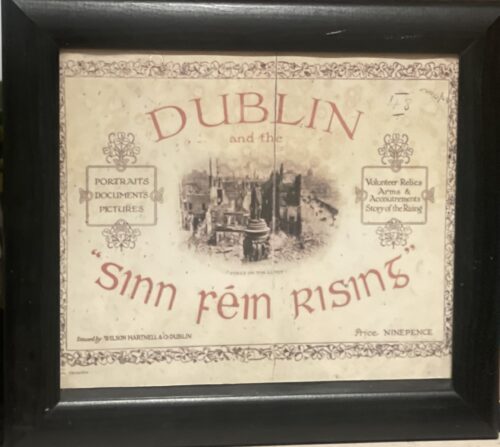 43cm x 38cm Dublin The Easter Rising (Irish: Éirí Amach na Cásca), also known as the Easter Rebellion, was an armed insurrection in Ireland during Easter Week in April 1916. The Rising was launched by Irish republicans against British rule in Ireland with the aim of establishing an independent Irish Republic while the United Kingdom was fighting the First World War. It was the most significant uprising in Ireland since the rebellion of 1798 and the first armed conflict of the Irish revolutionary period. Sixteen of the Rising's leaders were executed from May 1916. The nature of the executions, and subsequent political developments, ultimately contributed to an increase in popular support for Irish independence. Organised by a seven-man Military Council of the Irish Republican Brotherhood, the Rising began on Easter Monday, 24 April 1916 and lasted for six days.Members of the Irish Volunteers, led by schoolmaster and Irish language activist Patrick Pearse, joined by the smaller Irish Citizen Army of James Connolly and 200 women of Cumann na mBan, seized strategically important buildings in Dublin and proclaimed the Irish Republic. The British Army brought in thousands of reinforcements as well as artillery and a gunboat. There was street fighting on the routes into the city centre, where the rebels slowed the British advance and inflicted many casualties. Elsewhere in Dublin, the fighting mainly consisted of sniping and long-range gun battles. The main rebel positions were gradually surrounded and bombarded with artillery. There were isolated actions in other parts of Ireland; Volunteer leader Eoin MacNeill had issued a countermand in a bid to halt the Rising, which greatly reduced the number of rebels who mobilised. With much greater numbers and heavier weapons, the British Army suppressed the Rising. Pearse agreed to an unconditional surrender on Saturday 29 April, although sporadic fighting continued briefly. After the surrender, the country remained under martial law. About 3,500 people were taken prisoner by the British and 1,800 of them were sent to internment camps or prisons in Britain. Most of the leaders of the Rising were executed following courts-martial. The Rising brought physical force republicanism back to the forefront of Irish politics, which for nearly fifty years had been dominated by constitutional nationalism. Opposition to the British reaction to the Rising contributed to changes in public opinion and the move toward independence, as shown in the December 1918 election in Ireland which was won by the Sinn Féin party, which convened the First Dáil and declared independence. Of the 485 people killed, 260 were civilians, 143 were British military and police personnel, and 82 were Irish rebels, including 16 rebels executed for their roles in the Rising. More than 2,600 people were wounded. Many of the civilians were killed or wounded by British artillery fire or were mistaken for rebels. Others were caught in the crossfire during firefights between the British and the rebels. The shelling and resulting fires left parts of central Dublin in ruins.
43cm x 38cm Dublin The Easter Rising (Irish: Éirí Amach na Cásca), also known as the Easter Rebellion, was an armed insurrection in Ireland during Easter Week in April 1916. The Rising was launched by Irish republicans against British rule in Ireland with the aim of establishing an independent Irish Republic while the United Kingdom was fighting the First World War. It was the most significant uprising in Ireland since the rebellion of 1798 and the first armed conflict of the Irish revolutionary period. Sixteen of the Rising's leaders were executed from May 1916. The nature of the executions, and subsequent political developments, ultimately contributed to an increase in popular support for Irish independence. Organised by a seven-man Military Council of the Irish Republican Brotherhood, the Rising began on Easter Monday, 24 April 1916 and lasted for six days.Members of the Irish Volunteers, led by schoolmaster and Irish language activist Patrick Pearse, joined by the smaller Irish Citizen Army of James Connolly and 200 women of Cumann na mBan, seized strategically important buildings in Dublin and proclaimed the Irish Republic. The British Army brought in thousands of reinforcements as well as artillery and a gunboat. There was street fighting on the routes into the city centre, where the rebels slowed the British advance and inflicted many casualties. Elsewhere in Dublin, the fighting mainly consisted of sniping and long-range gun battles. The main rebel positions were gradually surrounded and bombarded with artillery. There were isolated actions in other parts of Ireland; Volunteer leader Eoin MacNeill had issued a countermand in a bid to halt the Rising, which greatly reduced the number of rebels who mobilised. With much greater numbers and heavier weapons, the British Army suppressed the Rising. Pearse agreed to an unconditional surrender on Saturday 29 April, although sporadic fighting continued briefly. After the surrender, the country remained under martial law. About 3,500 people were taken prisoner by the British and 1,800 of them were sent to internment camps or prisons in Britain. Most of the leaders of the Rising were executed following courts-martial. The Rising brought physical force republicanism back to the forefront of Irish politics, which for nearly fifty years had been dominated by constitutional nationalism. Opposition to the British reaction to the Rising contributed to changes in public opinion and the move toward independence, as shown in the December 1918 election in Ireland which was won by the Sinn Féin party, which convened the First Dáil and declared independence. Of the 485 people killed, 260 were civilians, 143 were British military and police personnel, and 82 were Irish rebels, including 16 rebels executed for their roles in the Rising. More than 2,600 people were wounded. Many of the civilians were killed or wounded by British artillery fire or were mistaken for rebels. Others were caught in the crossfire during firefights between the British and the rebels. The shelling and resulting fires left parts of central Dublin in ruins. -

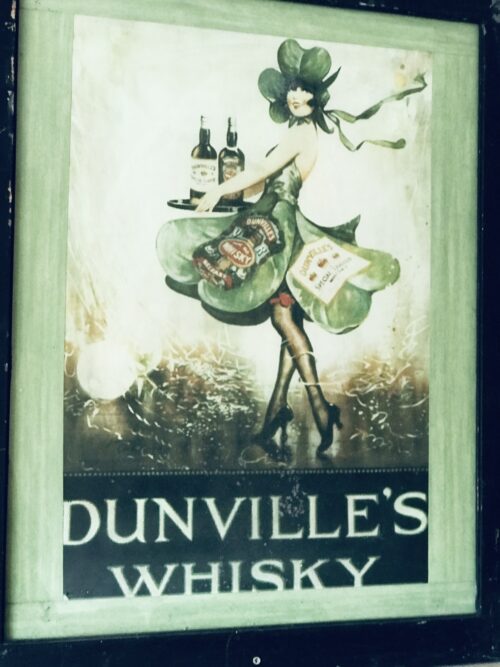 67cm x 52cm Dunville & Co Whisky Distillery was founded in Belfast Co Antrim in the 1820s,after initially gaining success as a whisky blender before constructing its own distillery.In 1837 Dunville began producing its most popular whiskey,Dunvilles VR.Athough Dunvilles was established and based in Ireland before partition and Irish Whiskey is normally spellt with an 'e',Dunvilles Whisky was always spelt without the vowel.
67cm x 52cm Dunville & Co Whisky Distillery was founded in Belfast Co Antrim in the 1820s,after initially gaining success as a whisky blender before constructing its own distillery.In 1837 Dunville began producing its most popular whiskey,Dunvilles VR.Athough Dunvilles was established and based in Ireland before partition and Irish Whiskey is normally spellt with an 'e',Dunvilles Whisky was always spelt without the vowel.

